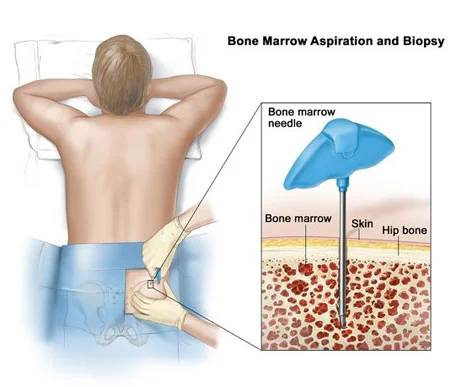


A bone marrow biopsy is a medical procedure used to obtain a sample of bone marrow tissue for examination under a microscope. This procedure is commonly performed to diagnose and monitor various blood disorders, such as leukemia, lymphoma, multiple myeloma, and certain types of anemia.
Treatment Procedure:
1. Preparation: Before the procedure, the patient's medical history is reviewed, and any relevant medications, such as blood thinners, may need to be adjusted or temporarily stopped to reduce the risk of bleeding during the biopsy. The patient may receive local anesthesia to numb the skin and underlying tissue at the biopsy site.
2. Positioning: The patient is typically positioned lying face down or on their side, exposing the area of the body where the biopsy will be performed. The most common sites for bone marrow biopsy are the posterior iliac crest (the back of the pelvic bone) and, less commonly, the sternum (breastbone).
3. Biopsy Procedure:
- The skin over the biopsy site is cleaned and sterilized to reduce the risk of infection.
- A local anesthetic is injected into the skin and underlying tissue to numb the area and reduce pain during the procedure.
- A special biopsy needle is then inserted through the skin and into the bone marrow space. The needle may be rotated or twisted to obtain a core sample of bone marrow tissue.
- Once the sample is obtained, the needle is removed, and pressure is applied to the biopsy site to minimize bleeding.
- A small bandage or dressing may be applied to the biopsy site.
4. Post-procedure Care: After the biopsy, the patient is monitored for any immediate complications, such as bleeding or signs of infection. Pain at the biopsy site can typically be managed with over-the-counter pain medications, and the patient can resume normal activities shortly after the procedure.
5. Sample Analysis: The bone marrow tissue sample obtained during the biopsy is sent to a laboratory for analysis under a microscope. A pathologist examines the sample for abnormalities in the bone marrow cells, such as abnormal cell morphology, increased or decreased cellularity, and the presence of cancerous or non-cancerous conditions.
Symptoms:
The symptoms associated with a bone marrow biopsy procedure are typically related to discomfort or pain at the biopsy site and may include:
- Pain or tenderness at the biopsy site, which may persist for a few days after the procedure.
- Bruising or swelling at the biopsy site.
- Rarely, bleeding or infection at the biopsy site, which may require medical attention.
It's important for patients undergoing a bone marrow biopsy to follow any post-procedure instructions provided by their healthcare provider and to report any unusual or concerning symptoms promptly. Most patients recover quickly from a bone marrow biopsy with minimal complications, and the procedure is generally considered safe and well-tolerated.